 Kale varieties Picture courtesy naturalflow from flickrCondensed Version
Kale varieties Picture courtesy naturalflow from flickrCondensed Version
Kale is filled with so many nutrients, vitamins and minerals that anyone serious about their health would be advised to include it regularly in their diets. There are countless varieties of kale, some with large plain leaves and others with very curly or crimped foliage called “savoyed”. Varieties with savoy leaves have a finer texture than those with smooth leaves.
Kale is a cool season crop that loves frost, and if established in late summer to autumn, the plants will continue to grow through winter. In cooler regions it can also do well if sown in early spring. Kale planted in late summer or early fall may sulk through spells of hot weather, but will perk up when conditions get colder, quickly multiplying in size. Kale prefers sun but will take semi-shade. It grows so quickly that you can start harvesting microgreens from from about 25 to 30 days after sowing, and as the plant matures you can harvest it all at once, or the outer leaves can be harvested as required.
Prepare the beds well in advance of sowing, adding compost, well-rotted manure and a dressing of organic 2:3:2. Kale prefers a pH of 6 to 7 and agricultural lime can be added to very acid soil. Seed is usually sown directly into the beds but can be raised in seedling trays and transplanted later. When sowing directly into beds sow the seeds in clumps or stations spaced about 30cm apart.
When the seedlings are about 15cm tall, thin them out, leaving only the strongest plant. Kale is drought hardy once established but in order to produce good quality, flavoursome leaves, it requires plentiful and consistent moisture. Feed every three weeks with a balanced organic fertiliser that is high in nitrogen.
Full Version
Description, History & Interesting Facts about Kale
Cold-hardy and resilient, kale is an easy member of the cabbage family to grow. Wild kale is native to the Mediterranean region of Europe where it has been cultivated for over 2,000 years. It remained the most widely eaten green vegetable in this region until the Middle Ages when cabbages became more popular. Actually, kale, cabbage, kohlrabi, cauliflower, broccoli and Brussels sprouts are all the same species of plant. The differences between them developed, due to years of human cultivation, selective seed selection and propagating. For example, because the leaves of kale were consumed, naturally those plants with the largest leaves would be selected and the seeds saved for the following season’s crops, and shared between gardeners as we do today. This resulted in larger-leafed plants slowly being developed.
Kale continued to be grown as a leafy vegetable for thousands of years, until at some point in time people realised that those tight clusters of tender leaves which were closely packed into the terminal flower bud at the top of the stem, were delicious, so they started selecting plants specifically for this trait. Hundreds of successive generations of plants later, resulted in the gradual formation of the cabbage "head" as we know it today.
By the Middle Ages kale had spread throughout Europe and Asia. Early Roman manuscripts include references to “brassica,” a word that encompassed wild turnips, cabbages and kale-like plants. Historically kale has been particularly important in colder regions due to its resistance to frost, and in the 19th century kale was grown as a staple crop in the Scottish Islands due to its extreme hardiness, and even fed to livestock through the winter. Kale was given some protection from the elements in purpose built ‘Kale Yards’. Indeed, almost every household had a kale yard and preserved kale in barrels of salt, similar to sauerkraut in Germany. Kale continued to be extremely important until potatoes came to the Islands at the end of the 18th century.
Kale continued to evolve, with the Italians developing plants with ‘scales’, the Scots creating leaves like frilly petticoats, and the Russians producing kale that could survive in the snow. Today there are countless varieties, some with large plain leaves and others with very curly or crimped foliage called “savoyed”. Varieties with savoy leaves have a finer texture than those with smooth leaves.
With the growing popularity of kale, many different heirloom and hybrid varieties have become available to home gardeners in South Africa, and with so many different types to choose from, you may be wondering which are best for you. Learn about the different kales to decide which ones will best suit your garden and taste.
How many different types of kale are there?
There are around 150 known kale varieties, and botanically, kale belongs to two different species:
Brassica oleracea (Acephala group)
These are the ‘true’ kales, which can be divided into two categories: “Scotch Kale” with its deeply curled and wrinkled leaves and “Lacinato Kale” with its dark green, savoyed, blade-shaped leaves.
Brassica napus (Pabularia group)
The “Siberian Kale” or “Russian Kale” varieties, with their large flat leaves with lobed or scalloped edges, belong to this species. It is commonly called Siberian kale for a good reason, as it is a cold weather vegetable.
What are the best kale varieties for the home garden?
If you are wondering which kale variety to grow, here are some of the most commonly grown types available in South Africa. If you don’t find the ones you are looking for in garden shops you will find them online.
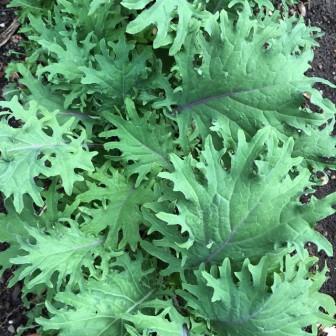 Kale 'Red Russian' Picture courtesy lostinbrooklyn from flickrKale ‘Red Russian’ (Brassica napus) Pabularia Group
Kale 'Red Russian' Picture courtesy lostinbrooklyn from flickrKale ‘Red Russian’ (Brassica napus) Pabularia Group
Russian Red Kale is an heirloom variety also known as “Ragged Jack” because it has a unique appearance, with frilly, almost raggedy looking blue-green leaves, with purplish-red stems. In fact, some gardeners cultivate it just for ornamental purposes. Hailing from Siberia, it is extremely cold hardy, and because it has a short shelf life, is not often found in supermarkets.
It offers a mild nutty flavour that is slightly sweet and earthy, with a hearty texture, and because it has large leaves that are softer than other varieties it does not require lots of cooking, and as a microgreen or baby leaf it is fantastic in salads.
It is ready for harvest around 65 days, and microgreens should be ready within 25 to 30 days. Basically, allow the plants to grow to knee height and then start harvesting the leaves. It generally grows between 60 and 90cm tall, but if not harvested all at once it will continue to grow, and will last at least two seasons in the garden.
Kale 'White Russian' (Brassica napus) Pabularia Group
White Russian Kale is a gently lobed, slender-leafed variety with beautiful sage-green leaves that are complimented by white stems. It looks a lot like a white-ribbed version of Red Russian Kale, and that’s no accident, since Red Russian is one of its ancestors. Bred by American plantsman Frank Morton from the Wild Garden Seeds gene pool in 1984, it resulted as a cross between Brassica napus ‘Red Russian’ and ‘Siberian’ kales. If allowed to reach maturity, it can reach 60cm in height or more. White Russian is great for pairing with Red Russian for an attractive colour blend in the garden.
Tender and delectable after a frost, White Russian is a nutritious favourite. This pale variety brings a sweet and tender taste to your dishes. As a microgreen it is delicious raw in salads, but does turn slightly sweeter when cooked, making it perfect in soups, stews, casseroles, and side dishes.
If you live in our winter rainfall regions, or in extremely cold regions this open pollinated variety is the kale for you. It’s a cold-loving Siberian heirloom that thrives in wet northern climates and is known to be the cold-hardiest kale, and also the one most tolerant of rainy winter weather and damp soils. As a baby green it can be harvested within 20 to 25 days, and matures around 50 to 60 days when it can be harvested all at once, or individual leaves can be cut as needed.
Kale 'Red Ursa' (Brassica napus) Pabularia Group
In the ‘90s, Frank Morton, an organic breeder of Wild Garden Seed in Corvallis, Oregon USA, crossed Siberian Kale with Red Russian Kale, and Red Ursa was born. In 1997 it was entered in the National Variety trials and was chosen as one of the top five vegetables of the year in the USA! This extra frilly version combines the broadleaf frills of ‘Siberian’ with the colour of ‘Red Russian’, resulting in a plant with striking dark red to purple stems and rich green leaves. Its disease resistance and its tolerance of both extremely cold weather and bolting during warm weather, extends the harvest season, making Red Ursa ideal for an early spring or autumn harvest.
When the plant is kissed by frost it intensifies not only the colour but also its sweet, distinct flavour. It tastes like kale should, with meaty leaves complemented by a sweet stem, and is wonderful to eat raw or cooked. As a younger, baby leaf, Red Ursa is terrific fresh in salads, and older leaves are perfect in stir-fries or comforting winter soups and stews.
The plant can be harvested for delicious baby leaves which are green with a hazy purple stem that blushes deeper purple in colder weather. The plant matures at around 60cm tall, and can be harvested within 65 days, or larger leaves can be harvested a few at a time as required.
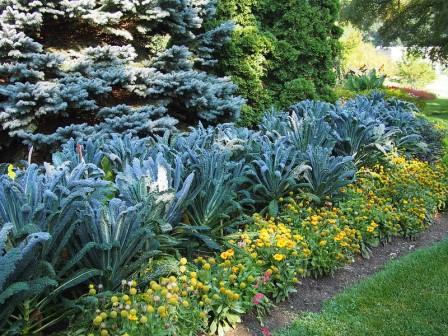 Kale 'Black Palm' Brassica oleracea 'Nero di Toscana' Michigan United States. Picture courtesy F D Richards From flickrBlack Palm Kale ‘Nero di Toscana’ (Brassica oleracea) Acephala Group
Kale 'Black Palm' Brassica oleracea 'Nero di Toscana' Michigan United States. Picture courtesy F D Richards From flickrBlack Palm Kale ‘Nero di Toscana’ (Brassica oleracea) Acephala Group
Black Palm Kale is an Heirloom variety from Tuscany that has been cultivated in Italy since at least the 1700’s. This type of Kale is also called “Lacinato Kale” and is one of the most productive crops you can grow, producing delicious, long, and slender leaves year-round. It also goes by the common names: “Black Tuscan Kale” and “Black Cabbage”. Black kale leaves are narrower than most other varieties with a blade-like shape. They are deeply veined and a dark greenish-purple to almost black. The plant is a biennial which can grow quite tall in its second year of growth, producing a sturdy stem that can reach up to 1.2m in height, and a leafy spread up to 90cm wide, hence the name “Dinosaur Kale”. And, because the leaves are harvested from the bottom up, the plant looks rather like a small palm tree, hence the common name “Palm Kale”.
It is an essential ingredient in the famed Tuscan soup called “Rabolita” made from leftover bread and the minestrone or other vegetable soups from previous meals. Black Palm Kale is famous for its flavour which, when enhanced by a touch of frost becomes sweeter. It is one of the traditional ingredients of minestrone and a favourite for stews. The young leaves can be eaten raw in salad, made into kale chips, or just simply rubbed with olive oil and baked until crispy.
You can harvest black palm kale for baby greens approximately 25 to 30 days after sowing, or you can allow the foliage to mature and start harvesting at about 60 to 90 days. Black palm kale is a very hardy year round crop, but does best in winter.
Kale ‘Dazzling Blue’ (Brassica oleracea) Acephala Group
By back crossing ‘Lacinato Rainbow’ with the Wild Garden Seed ‘Lacinato’, ‘Dazzling Blue’ was born, thanks to Hank Keogh from Avoca farm in Oregon, USA. This variety really lives up to its name with its rough, wrinkled and creased blue-green leaves, that are tinged with pink and purple, with bright purple nerves and vibrantly pink-purple stems.
Dazzling Blue has that classic “Lacinato Kale” leaf shape plus all the flavour, making this tender kale great for sautéing and steaming, and adding to salads. The delicate flavour improves and the colouring of the leaves intensifies in cold weather.
Dazzling Blue has a well-earned reputation for being more winter hardy than other strains of Lacinato Kale, and is also very vigorous. It grows around 1 to 1.5m tall with a spread of 90cm or more, and in season two it can grow to 2m tall. The plant is ready for harvest around 60 to 90 days after sowing, and microgreens are harvested after 25 to 30 days.
Kale ‘Vates Blue Curled’ (Brassica oleracea) Acephala Group
Vates Blue is an open pollinated variety with Scottish roots that thrives in cold weather, and is also known as “Curled Scotch Kale”, and “Curly Kale”. It is a dwarf, low-growing variety with finely curled blue-green leaves that are quite delicious.
The succulent mild flavour makes it a good addition to fresh salads and for juicing. It is also used in stir fries and is great for making kale chips.
Vates Blue only grows 30 to 40cm tall with a 60cm spread, making it suitable to grow in large pots. Because it is very cold hardy, and is also slow to bolt in hot weather this type is suitable to grow in warmer regions. For microgreens it will be ready to harvest within 30 to 40 days and for mature leaves it will be ready to harvest within 60 to 90 days. It’s a really good “cut-and-come-again” plant, meaning you can trim the mature leaves as needed for a continuous supply of fresh greens.
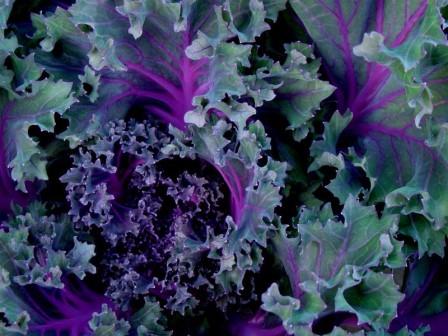 Kale 'Scarlet' Picture courtesy Doug McAbee from flickrKale ‘Scarlet Curled’ (Brassica oleracea)
Kale 'Scarlet' Picture courtesy Doug McAbee from flickrKale ‘Scarlet Curled’ (Brassica oleracea)
This super stunning open pollinated kale is pretty enough to use in the flower garden with its large, densely curled violet-green leaves that turn a gorgeous violet-red as the temperatures drop in winter.
Of all the kale varieties its leaves are the most tender and mild tasting, making young baby leaf scarlet kale perfect for fresh salads, and delicious lightly steamed and tossed with some olive oil. More mature leaves are added to soups and casseroles, and if you are specifically looking for a juicing kale, this one is perfect.
Scarlet Kale is a very winter hardy biennial, and it is also resistant to bolting during the warmer summer months, enabling gardeners to produce reliable yields in both spring and autumn. It produces strong stems and can grow 60 to 90cm tall with a spread of 60cm. As a baby leaf it can be picked anything from 25 to 30 days and a mature harvest around 55 to 65 days after sowing. Individual leaves can be harvested as required throughout the year.
Kale ‘Chou Moullier’ (Brassica oleracea) Acephala Group
Chou Moullier is an heirloom variety with very large, fairly flat green leaves with just a bit of curl at the edges. This species is the tallest growing of the forage brassicas, and it can reach up to 2.5m tall with a strong, tall trunk and a broad, leafy spread, hence its common name “Tree Kale”. It is also called “Thousand Headed Kale”, and “Boerkool”.
It has a delicious crisp texture and tastes a bit like a blend of cabbage and Brussels sprouts. The young baby leaves are a wonderful raw green veggie, and the stems are thick, juicy and sweet. The larger leaves are often used in stir-fries, but they can also be steamed or boiled. They also make great kale chips and can be added to smoothies.
This lovely hardy kale variety just keeps on giving and is most productive in the garden. Once established it will handle frost well, and planting or sowing in late summer is recommended for heading in early spring, as this kale does not handle extreme heat well. Baby leaves are harvested within 25 to 30 days after sowing, and you can harvest the entire crop within 60 to 100 days, or, if you pick leaves from bottom of stem up this biennial kale will reward you with a succession of new leaves for a long time.
Curly Kale ‘Halbhoher Grüner Krauser’ (Brassica oleracea var. sabellica)
This incredibly popular open pollinated kale variety was recognized as rare by a wonderful foundation called "sativa" that works to preserve the diversity of rare plant varieties. It is active in the care of these traditional plants, and sells them to gardeners to ensure their survival. Click here to visit their website.
Halbhoher Grüner Krauser produces heavily curled, medium sized dark green leaves with an outstanding flavour that can be prepared like spinach. It is exceptionally good with garlic and can be added to thick and creamy potato, bean, sausage soups, or roasted sweet potato dishes.
Curly kale will grow to a height of around 60 to 70cm and a spread of 30cm, and is so pretty you could add it to your winter flower borders. Because it’s cold and frost tolerant it is ideal for autumn sowings. Microgreens can be harvested early and the entire plant can be harvested within 100 to 120 days, or individual leaves can be harvested throughout the season as needed.
Portuguese Kale/Cabbage (Brassica oleracea var. tronchuda)
If you live in a subtropical, tropical, or arid, climate this kale is perfect for you because it can take the heat. It is also great to grow in cool or temperate regions. However, it does not like the cold and is a crop that you start in spring to harvest throughout summer and autumn then scurry to gather leaves before the first hard freeze. Portuguese kale, called “Couve Tronchuda” is an heirloom vegetable often referred to as a kale or as a leaf cabbage, and although it has many similarities to a kale with its loose leaf growing habit, the flavour and leaf texture is definitely closer to that of a cabbage.
Health Benefits of Kale
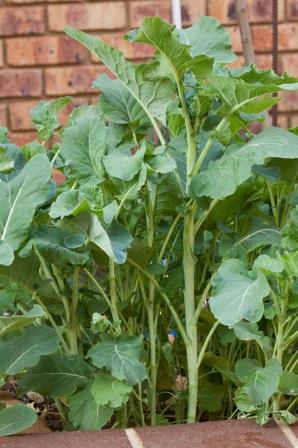 Kale 'Chou Moullier' Picture courtesy www.ballstraahof.co.zaKale is low in calories, has zero fat, and is high in fibre, aiding in digestion and elimination. It has more iron than beef per calorie, and more calcium than milk per calorie. Iron is a mineral found in every cell of the body and essential because it is needed to make haemoglobin, a part of blood cells. Calcium aids in preventing bone loss, preventing osteoporosis and maintaining a healthy metabolism.
Kale 'Chou Moullier' Picture courtesy www.ballstraahof.co.zaKale is low in calories, has zero fat, and is high in fibre, aiding in digestion and elimination. It has more iron than beef per calorie, and more calcium than milk per calorie. Iron is a mineral found in every cell of the body and essential because it is needed to make haemoglobin, a part of blood cells. Calcium aids in preventing bone loss, preventing osteoporosis and maintaining a healthy metabolism.
This wonderful vegetable is filled with powerful antioxidants such as carotenoids and flavonoids, helping protect against various cancers. The high Vitamin K content of kale also helps protect against various cancers. Vitamin K is also necessary for a wide variety of bodily functions including normal bone health and blood clotting. Increased levels of vitamin K can help people suffering from Alzheimer’s disease.
Kale is a great anti-inflammatory food, and one cup of kale has 10% of the RDA of omega-3 fatty acids, which help fight against arthritis, asthma and autoimmune disorders. Kale is also great for cardiovascular support and eating more kale can help lower cholesterol levels.
It is high in Vitamin A and Vitamin C. Vitamin A is great for your vision and your skin, and Vitamin C is very helpful for your immune system, your metabolism and hydration. Vitamin C is also helpful to maintain cartilage and joint flexibility. Kale is filled with so many nutrients, vitamins and minerals that anyone serious about their health would be advised to include it regularly in their diets.
Cooking with Kale
Kale is used in cooking in much the same way as cabbage. The tender young leaves can be eaten raw and are wonderful in salads. More mature leaves are wonderful steamed, or cooked in soups and stews. Kale is also a healthy addition to stir fries and can be substituted for spinach in omelettes, casseroles, or even quesadillas - wheat, flour or a corn tortilla’s which are filled with cheese, and often with other items like a savoury mixture of spices or vegetables. Baked kale chips are delicious and the young leaves are added to smoothies for their health-giving properties.
Using Kale in the Garden
When the weather warms, your kale plants will send up tall flower stalks with pretty, bright yellow flowers, making them very ornamental in the garden and you can cut the flowers for arrangements.
If you are intent on saving the seeds for next season or to grow microgreens, make sure to pick open-pollinated, heirloom varieties. F1 hybrids may be strong in some aspects but they can be vulnerable in others. These hybrids are also usually sterile, meaning that they will not produce viable seed, and you will have to purchase fresh seed every season if you want to keep growing that variety.
Companion Plants for Kale
Petunias make excellent companions for kale and will act as a tonic plant. Grow kale together with table celery, celeriac, rosemary, sage and thyme, as these companion plants deter the cabbage moth. Table celery will help prevent grubs.
Cultivating and Harvesting Kale
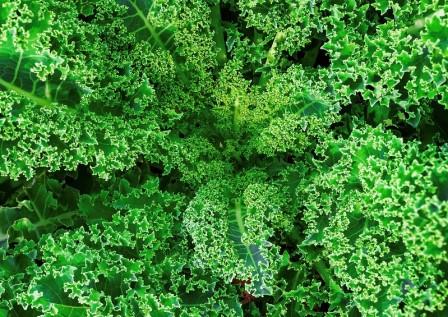 Kale 'Halbhoher Curly' Picture courtesy Terry Donovan from flickrKale is a cool season crop that loves frost, and if established in late summer to autumn, the plants will continue to grow through winter. In cooler regions it can also do well if sown in early spring. Kale planted in late summer or early fall may sulk through spells of hot weather. Then, when conditions get colder the plants will take off, quickly multiplying in size. Kale prefers full sun but will tolerate semi-shade.
Kale 'Halbhoher Curly' Picture courtesy Terry Donovan from flickrKale is a cool season crop that loves frost, and if established in late summer to autumn, the plants will continue to grow through winter. In cooler regions it can also do well if sown in early spring. Kale planted in late summer or early fall may sulk through spells of hot weather. Then, when conditions get colder the plants will take off, quickly multiplying in size. Kale prefers full sun but will tolerate semi-shade.
Prepare the beds well in advance of sowing, adding compost, well-rotted manure and a dressing of organic 2:3:2. Kale prefers a pH of 6 to 7 and agricultural lime can be added to very acid soil.
Seed is usually sown directly into the beds but can be raised in seedling trays and transplanted later. When sowing directly into beds sow the seeds in clumps or stations spaced about 30cm apart. When the seedlings are about 15cm tall, thin them out, leaving only the strongest plant.
Kale is drought hardy once established but in order to produce good quality, flavoursome leaves, it requires plentiful and consistent moisture. Feed every three weeks with a balanced organic fertiliser that is high in nitrogen.
It grows so quickly that you can start harvesting young baby leaves from about within 25 to 30 days, and depending on the variety grown kale should mature around 50 to 65 days. The outer leaves can be harvested individually as required, or the whole plant harvested at once.
Propagating Kale
Being biennial, kale produces yellow flowers followed by elongated seedpods in its second year. Allow the seedpods to develop and dry on the plants to a tan colour before gathering them in a paper bag and breaking the pods open to collect the seeds. If stored in a cool, dry and dark place, kale seeds will store for up to three years. Be sure to work only with open-pollinated varieties when saving seeds, because hybrid varieties may not breed true from seed.
What is the difference between open pollinated Heirloom Seeds and F1 Hybrids?
If you are intent on saving the seeds for next season or to grow microgreens, make sure to pick open-pollinated, heirloom varieties. F1 hybrids may be strong in some aspects but they can be vulnerable in others. These hybrids are also usually sterile, meaning that they will not produce viable seed, and you will have to purchase fresh seed every season if you want to keep growing that variety.
Pests & Diseases of Kale
Kale grown in winter is generally a carefree crop, but as the weather warms up there are several insects that enjoy eating kale as much as people do.
Watch out for velvety green cabbage worms chewing holes in the leaves. Also, for outbreaks of grey-green cabbage aphids, which often gather in clusters within the folds of frilly kale leaves.
Treat small problems by spraying with an insecticidal soap and pick off and discard badly infested leaves.
Towards the end of the growing season colourful black-and-orange harlequin bugs may show up on kale plants. Rather than fight the harlequins, most gardeners harvest the remainder of the crop and prepare the beds for the following harvest.
Caution
The information contained within this website is for educational purposes only, documenting the traditional uses of specific plants as recorded through history. Always seek advice from a medical practitioner before starting a home treatment programme.


